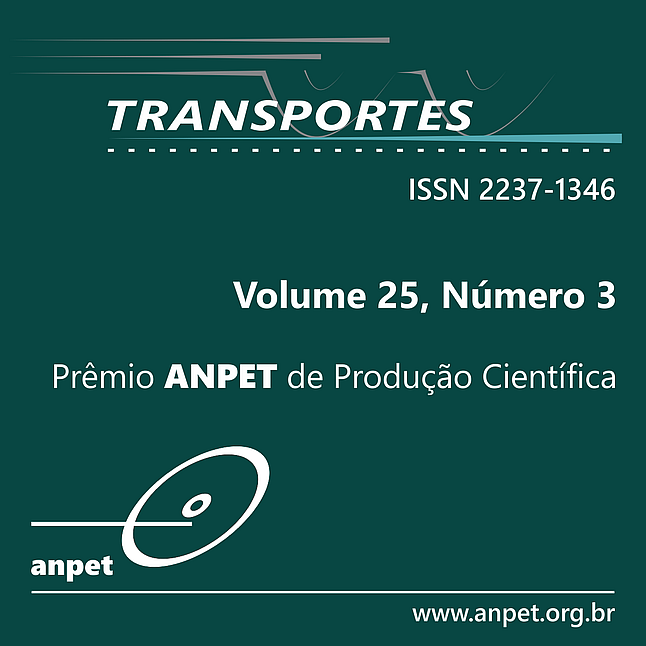Análise da capacidade de infiltração em pavimento permeável de bloco de concreto unidirecionalmente articulado
DOI:
https://doi.org/10.14295/transportes.v25i3.1314Keywords:
Permeable pavements, Articulated concrete blocks, Permeability.Abstract
The adoption of permeable pavements has become increasingly necessary as a compensatory measure in order to attenuate peak flows and mitigate the effects caused by rainwater in densely urbanized areas. Usually composed of interlocked concrete blocks, pervious concrete or porous asphalt, the traditional permeable pavements do not always comply with the required levels of permeability. In this context, this paper analyzed the in situ infiltration capacity of articulated concrete blocks as alternative material for surface layer, differentiated by their structure and geometrical design. Therefore, a 20-m-long and 5-m-wide pavement test section was constructed at the University of São Paulo Campus, which allowed determining the permeability coefficient in a field evaluation. Hence, the values obtained were compared to those from the pertinent literature using conventional materials. The test results showed that the articulated concrete block presents a high permeability of around 10-3 m/s, being considerably greater than those found in pavements built with both interlocked concrete blocks and with porous asphalt.
Downloads
References
ABNT (2013) NBR 9781 – Peças de concreto para pavimentação – Especificação e métodos de ensaio. Associação Brasileira de Normas Técnicas, Rio de Janeiro.
ABNT (2015) NBR 16416 – Pavimentos permeáveis – requisitos e procedimentos. Associação Brasileira de Normas Técnicas, Rio de Janeiro.
Araújo, P. R; Tucci, C.E.; Goldenfum, J. A. (2000) Avaliação da eficiência dos pavimentos permeáveis na redução do escoamento superficial. RBRH – Revista Brasileira de Recursos Hídricos. v. 5, n. 3, p. 21-29. DOI: 10.21168/rbrh.v5n3.p21-29.
ASTM (2009) C1701/C1701M – Standard test method for infiltration rate of in place pervious concrete. American Society for Testing and Materials, West Conshohocken, Pensilvânia.
ASTM (2014) D6684 – Standard specification for materials and manufacture of articulating concrete block revetment systems. American Society for Testing and Materials, West Conshohocken, Pensilvânia.
ASTM (2016) C140 – Standard tests methods for sampling and testing concrete masonry and related units. American Society for Testing and Materials. West Conshohocken, Pensilvânia.
ASCE (1992) – Design and construction of urban stormwater management systems. American Society Of Civil Engineers. New York.
Marchioni, M. S.; Silva C. O. (2013) Método de ensaio para avaliação de pavimento permeável executado. In: Anais do 55º Con-gresso Brasileiro do Concreto, Gramado.
Martins, R. M. (2014) Análise da Capacidade de Infiltração do Pavimento Intertravado de Concreto. Universidade Tecnológica Federal do Paraná, Pato Branco.
Pellizzari, V. (2013) Avaliação da Eficácia da Restauração da Capacidade de Infiltração da Camada Superior de Pavimentos Poro-sos. Trabalho de Conclusão de Curso. Universidade Federal do Rio Grande do Sul – Departamento de Engenharia Civil, Porto Alegre.
Pinto, L. L (2011) O desempenho de pavimentos permeáveis como medida mitigadora da impermeabilização do solo urbano. Tese de doutorado – Escola Politécnica da Universidade de São Paulo. São Paulo, 2011.
Sales, T. D. (2008). Pavimento permeável com superfície em blocos de concreto de alta porosidade. Dissertação de Mestrado. Universidade Federal de Santa Catarina, Florianópolis.
Santos, L. P.; Cuba, R. M.; Leitão, V. S.; Neto, A. S. (2015) Análise da eficiência de calçadas ecológicas como sistema de drenagem sustentável nos centros urbanos: estudo de caso no Parque Flamboyant, Goiânia–Goiás. Revista Eletrônica em Gestão, Educa-ção e Tecnologia Ambiental, v. 19, n. 3, p. 837-849. DOI: 105902/2236117018345.
Seoul Metropolitan Government – SMG (2014) Importance of the technology: field permeability test. Apresentação em Power-Point. Seoul.
Tucci, C. M.; Tozzi, M. J. (1998) Drenagem urbana: gerenciamento, simulação, controle. Associação Brasileira de Recursos Hídricos, p. 155-163. Editora UFRGS, Porto Alegre.
Tucci, C. M.; Bertoni, J. C. (2003) Inundações urbanas na América do Sul. Associação Brasileira de Recursos Hídricos, Porto Alegre.
Virgiliis, A. D. (2009). Procedimentos de projeto e execução de pavimentos permeáveis visando retenção e amortecimento de picos de cheias. Dissertação de Mestrado – Escola Politécnica da Universidade de São Paulo, São Paulo.
Weiss, P. T.; Kayhanian, M.; Khazanovich, L.; Gulliver, J. S. (2015) Permeable pavements in cold climates: state of the art and cold climate case studies – Report. Center for Transportation Studies. University of Minessota, Minneapolis.
Downloads
Published
How to Cite
Issue
Section
License
Authors who submit papers for publication by TRANSPORTES agree to the following terms:
- The authors retain the copyright and grant Transportes the right of first publication of the manuscript, without any financial charge, and waive any other remuneration for its publication by ANPET.
- Upon publication by Transportes, the manuscript is automatically licensed under the Creative Commons License CC BY 4.0 license. This license permits the work to be shared with proper attribution to the authors and its original publication in this journal.
- Authors are authorized to enter into additional separate contracts for the non-exclusive distribution of the version of the manuscript published in this journal (e.g., publishing in an institutional repository or as a book chapter), with recognition of the initial publication in this journal, provided that such a contract does not imply an endorsement of the content of the manuscript or the new medium by ANPET.
- Authors are permitted and encouraged to publish and distribute their work online (e.g., in institutional repositories or on their personal websites) after the editorial process is complete. As Transportes provides open access to all published issues, authors are encouraged to use links to the DOI of their article in these cases.
- Authors guarantee that they have obtained the necessary authorization from their employers for the transfer of rights under this agreement, if these employers hold any copyright over the manuscript. Additionally, authors assume all responsibility for any copyright infringements by these employers, releasing ANPET and Transportes from any responsibility in this regard.
- Authors assume full responsibility for the content of the manuscript, including the necessary and appropriate authorizations for the disclosure of collected data and obtained results, releasing ANPET and Transportes from any responsibility in this regard.









